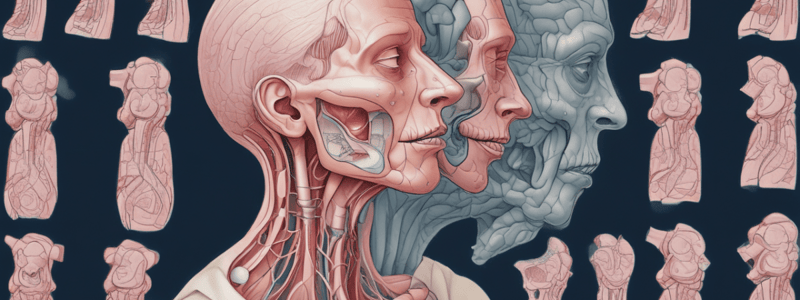Podcast
Questions and Answers
What is the most common risk factor for HPV-positive squamous cell carcinomas of the oropharynx?
What is the most common risk factor for HPV-positive squamous cell carcinomas of the oropharynx?
- Excessive use of the voice
- Tobacco smoking and/or alcohol abuse
- High-risk human papillomavirus (commonly type 16) (correct)
- Chronic irritation from heavy cigarette smoking
Which feature is typically seen in juvenile laryngeal papillomatosis?
Which feature is typically seen in juvenile laryngeal papillomatosis?
- Localized to the true vocal cords
- Recurrence after resection is uncommon
- Usually due to low-risk HPV infections (types 6 and 11)
- May extend into the trachea and bronchi, threatening the airway (correct)
What is the most common microscopic appearance of HPV-positive squamous cell carcinomas of the oropharynx?
What is the most common microscopic appearance of HPV-positive squamous cell carcinomas of the oropharynx?
- Non-keratinizing squamous cell carcinoma (correct)
- Adenocarcinoma
- Keratinizing squamous cell carcinoma
- Verrucous carcinoma
What is the most common location for a Singer's nodule?
What is the most common location for a Singer's nodule?
Which statement is true about squamous papillomas of the larynx?
Which statement is true about squamous papillomas of the larynx?
What is the most common malignancy in the upper respiratory tract?
What is the most common malignancy in the upper respiratory tract?
What is the most likely cause of acute rhinitis with symptoms of coryza, sneezing, nasal congestion, and mild sore throat?
What is the most likely cause of acute rhinitis with symptoms of coryza, sneezing, nasal congestion, and mild sore throat?
Which organism is most commonly associated with causing rhinoscleroma?
Which organism is most commonly associated with causing rhinoscleroma?
What is the hallmark of allergic rhinitis involving mast cells?
What is the hallmark of allergic rhinitis involving mast cells?
Which condition is likely to result in fibrous scarring, decreased vascularity, and atrophy of the epithelium and mucous glands?
Which condition is likely to result in fibrous scarring, decreased vascularity, and atrophy of the epithelium and mucous glands?
What is a common tumor of the nasopharynx?
What is a common tumor of the nasopharynx?
What is the most common cause of acute laryngotracheobronchitis (croup)?
What is the most common cause of acute laryngotracheobronchitis (croup)?
Which of the following is a characteristic symptom of acute laryngotracheobronchitis (croup)?
Which of the following is a characteristic symptom of acute laryngotracheobronchitis (croup)?
What type of tumor is angiofibroma?
What type of tumor is angiofibroma?
Which of the following is the most common malignant nasal tumor?
Which of the following is the most common malignant nasal tumor?
What is the characteristic feature of olfactory neuroblastomas?
What is the characteristic feature of olfactory neuroblastomas?
What is the relationship between Epstein-Barr virus and nasopharyngeal carcinoma?
What is the relationship between Epstein-Barr virus and nasopharyngeal carcinoma?
Flashcards are hidden until you start studying
Study Notes
Upper Respiratory Tract Diseases
- Rhinitis is a common illness, caused by viruses, especially adenoviruses, and manifests with coryza, sneezing, nasal congestion, and mild sore throat.
- Acute rhinitis types include:
- Common cold
- Allergic rhinitis (IgE type I immune reaction involving mast cells)
- Bacterial infection (superimposed on acute viral or allergic rhinitis)
Rhinoscleroma
- Granulomatous inflammation of the upper respiratory tract
- Primarily affects the nose, but also nasopharynx, larynx, and trachea
- Caused by Klebsiella rhinoscleromatis
- Endemic in Egypt
Epistaxis
- No specific causes mentioned
Laryngitis
- Acute laryngotracheobronchitis (croup) is a potentially life-threatening condition in infants
- Caused by viral infection
- Characteristics: harsh cough and inspiratory stridor
Tumors of the Upper Respiratory Tract
Nose, Nasal Sinuses, and Nasopharynx
- Angiofibroma: vascular neoplasm, adolescent males, common in posterior-lateral nasal wall and nasopharynx
- Nasopharyngeal carcinoma (previously known as lymphoepithelioma): most common in Southeast Asia and East Africa, caused by Epstein-Barr virus
- Squamous cell carcinoma: most common malignant nasal tumor
- Adenocarcinoma: 5% of malignant tumors, includes intestinal-type and non-intestinal-type cases
- Olfactory neuroblastomas: arise from olfactory mucosa, usually in older male patients
- Plasmacytoma: extraosseous form of plasma cell neoplasms
- Embryonal rhabdomyosarcoma: aggressive mesenchymal malignancy, most common in young children
Oropharynx
- Squamous cell carcinomas: incidence is the vast majority of malignancies, risk factor is high-risk human papillomavirus (HPV), especially type 16
Larynx
- Singer's nodule: small, benign laryngeal polyp, usually induced by chronic irritation and excessive use of voice
- Squamous papilloma: benign neoplasm, usually around the true vocal cords, may rarely undergo malignant change, usually due to low-risk HPV infections (types 6 and 11)
Studying That Suits You
Use AI to generate personalized quizzes and flashcards to suit your learning preferences.


